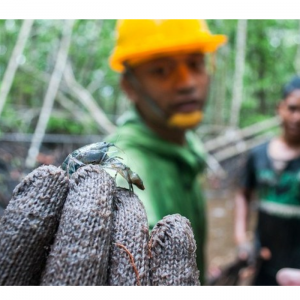
'Charismatic Carbon'
| Tue, 24 Sep 2019 - 15:13

According to the Intergovernmental Panel on Climate Change (IPCC), addressing carbon emissions from our food sector is absolutely essential to combating climate change. While land and agriculture took center stage in the panel’s most recent report, missing was how the oceans at large could help in that fight.
Seaweed, perceived by some as little more than marine debris on the beach, could be a new player in the effort to mitigate climate change. So say researchers at UC Santa Barbara, who investigated the carbon offsetting potential of seaweed aquaculture.
“It’s not a silver bullet, nor an industry that exists yet,” said Halley Froehlich, an assistant professor in the Department of Environmental Studies and in the Department of Ecology, Evolution and Marine Biology. “But it has huge potential.” Froehlich is lead author of a first-ever global assessment of seaweed aquaculture’s carbon sequestration scaling potential, which appears in Current Biology.
According to Froehlich and co-authors Jamie Afferbach, Melanie Frazier and Benjamin Halpern from the National Center for Ecological Analysis and Synthesis, who synthesized diverse datasets from scientific literature, seaweed aquaculture could indeed be a powerful new way to sequester carbon. The process would involve cultivating seaweed and harvesting it for the purpose of sinking the algae in the deeper ocean, where the carbon stored in its tissues would remain ‘buried.’
“We really wanted to know if it could be beneficial, but also be realistic about its potential,” Froehlich said of the research, which they bounded with constraints including nutrients, temperature and geographic suitability, as well as assessed production growth and cost. The researchers also investigated the mitigation potential on various scales with a focus on the food sector — a major source of greenhouse gases and considerable hurdle to fight climate change.
There is substantial suitable area — roughly 48 million square kilometers — in which seaweed could be farmed, and a relatively small proportion (0.001%) would be enough to render the entire global aquaculture industry carbon neutral, according to the study.
However, the benefits don’t scale proportionally against the much higher greenhouse gas-emitting global agricultural sector, in part due to cost and growth constraints, Froehlich said. Farming seaweed alone won’t balance emissions from global food production, she added, but could be a useful new tool in a suite that includes other carbon reduction and offset measures such as cleaner sources of energy, reforestation and protection of carbon sinks.
Greenhouse gas-mitigating seaweed farming could have the most potential when it comes to achieving local and regional carbon neutrality goals, the study found. California is particularly well-primed to reap the mitigating benefits of seaweed aquaculture, given the state’s strong climate action policy and its long, nutrient-rich coast. An area of only 3.8% of the West Coast Exclusive Economic Zone (a marine zone that extends no more than 200 miles from the coast) would be enough to offset the carbon produced by the state’s agriculture sector.
Relative to the rest of the world, U.S. seaweed aquaculture is still somewhat in its infancy.
“The vast majority of seaweed aquaculture occurs in Southeast Asia,” Froehlich said. While no measurable seaweed farming was occurring in the United States in 2016 — the most recent time period of the study — small seaweed farms are starting to emerge in the U.S., though primarily for food and other commercial purposes, and not for carbon sequestration.
The U.S., meanwhile, is the world’s second-biggest emitter of greenhouse gases, Froehlich pointed out, underscoring the need for solutions such as seaweed farming to mitigate the millions of tons of carbon dioxide equivalents the country emits per year. Fortunately, seaweed farming has other appealing and beneficial environmental effects, she noted.
“We like to call it ‘charismatic carbon’ because it has additional benefits,” Froehlich said, “such as potentially providing habitat for fish and other marine life, reducing ocean acidification and oxygen depletion, and taking up excess nutrients in local areas.”
Seaweed cultivation’s beneficial climate effects far outweigh the fact that it can’t completely offset the country’s food production greenhouse gas emissions. In fact, according to co-author Halpern, there is not — and never will be — a single tool for dealing with climate change.
“The problem has become too big for simple solutions,” he said. “We need all hands on deck.” While solutions to climate change will not be easy, he added, the more strategies, the better.
“The huge advantage is that if we can actually deploy many different strategies — from seaweed farming to renewable energy to energy efficiency and others — the solution is more resilient,” Halpern said.
To make it a real option in the United States, policy would need to enable and accelerate seaweed cultivation for carbon sequestration, farmers would need to respond by dramatically scaling up production and the carbon market would need to expand to offer higher prices.
In the meantime, research will continue to investigate seaweed cultivation’s potential for mitigating climate change.
“My colleagues and I are now assessing other paths seaweed can take to find the ‘best bang for your buck’ on carbon mitigation,” Froehlich said. Given that farmed seaweed is also subject to climate change effects, a better understanding of how it could be affected would greatly inform how it could be cultivated and managed in the long term.
Source : news.ucsb.edu






















